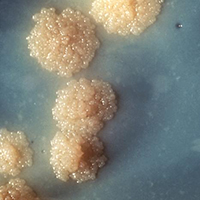Incidence rate and time to serious adverse events among rifampicin resistant tuberculosis patients in Georgia treated with new and repurposed anti-tuberculosis drugs, 2016-2018

Published: January 14, 2021
Abstract Views: 1515
PDF: 778
Supplementary: 124
Supplementary: 124
Publisher's note
All claims expressed in this article are solely those of the authors and do not necessarily represent those of their affiliated organizations, or those of the publisher, the editors and the reviewers. Any product that may be evaluated in this article or claim that may be made by its manufacturer is not guaranteed or endorsed by the publisher.
All claims expressed in this article are solely those of the authors and do not necessarily represent those of their affiliated organizations, or those of the publisher, the editors and the reviewers. Any product that may be evaluated in this article or claim that may be made by its manufacturer is not guaranteed or endorsed by the publisher.
Similar Articles
- Furio Colivicchi, David Mocini, Massimo Uguccioni, Stefano Strano, Giuseppe Imperoli, Massimo Santini, Smoking cessation interventions after Acute Coronary Syndromes. Results of a cross-sectional survey in the Lazio Region of Italy , Monaldi Archives for Chest Disease: Vol. 78 No. 2 (2012): Cardiac series
- Marco Ambrosetti, Tommaso Diaco, Oreste Febo, Pasqualina Calisi, Giuseppe Favretto, Roberto Carlon, Pier Luigi Temporelli, ATHerosclerosis of the lower extremIties as a liNKed comorbidity in Patients Admitted for carDiac rehabilitation (THINKPAD): rationale, design, and study group , Monaldi Archives for Chest Disease: Vol. 78 No. 1 (2012): Cardiac series
- Kostiantyn Dmytriiev, Yuriy Mostovoy, Nataliia Slepchenko, Yuliia Smereka, Clinical course of COPD in patients with Arg16Gly (rs1042713) polymorphism of ADRB2 gene , Monaldi Archives for Chest Disease: Vol. 93 No. 2 (2023)
- M. Confalonieri, M. Kodric, M. Santagiuliana, C. Longo, M. Biolo, R. Cifaldi, C. Torregiani, M. Jevnikar, To use or not to use corticosteroids for pneumonia? A clinician’s perspective , Monaldi Archives for Chest Disease: Vol. 77 No. 2 (2012): Pulmonary series
- Maurizio Giuseppe Abrignani, Giovanni De Luca, Michele Gabriele, Nidal Tourkmani, The Health Department of Sicily “Regional recommendations for hospital discharge and communication with patients after admission due to a cardiologic event†Decree , Monaldi Archives for Chest Disease: Vol. 82 No. 2 (2014): Cardiac series
- M. Vitacca, L. Bianchi, A. Bazza, E.M. Clini, Advanced COPD patients under Home Mechanical Ventilation and/or Long Term Oxygen Therapy: Italian Healthcare Costs , Monaldi Archives for Chest Disease: Vol. 75 No. 4 (2011): Pulmonary series
- Gian Francesco Mureddu, Pompilio Faggiano, Francesco Fattirolli, Preoperative evaluation before non cardiac surgery in subjects older than 65 years , Monaldi Archives for Chest Disease: Vol. 82 No. 1 (2014): Cardiac series
- Musaib Alavi, Waris Ali, Alaeddin Sagar, Majid Shafiq, Muhammad Azhar, Akbar S. Ali, Moiz Salahuddin, Real-world effectiveness and safety of handheld ultrasound in pleural procedures , Monaldi Archives for Chest Disease: Early Access
- Biagio Polla, Roflumilast is effective in reducing COPD related exacerbations and improving CAT score , Monaldi Archives for Chest Disease: Vol. 79 No. 3-4 (2013): Pulmonary series - Supplement 1
- Alberto Genovesi Ebert, Furio Colivicchi, Marco Malvezzi Caracciolo, Carmine Riccio, Additive beneficial effects of beta blockers in the prevention of symptomatic heart failure , Monaldi Archives for Chest Disease: Vol. 72 No. 1 (2009): Cardiac series
<< < 13 14 15 16 17 18 19 20 21 22 > >>
You may also start an advanced similarity search for this article.

 https://doi.org/10.4081/monaldi.2021.1649
https://doi.org/10.4081/monaldi.2021.1649




